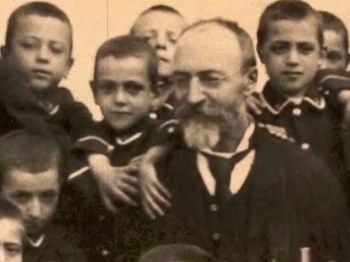Blessed Bartolo Longo

Interest in the only lay member of the Order to have been declared blessed continues to grow: in fact he appears as a model of Christian life in these difficult times. His life shows us that no earthly difficulties are immune to the liberating power of divine mercy.
Bartolo Longo was a practitioner of spiritualism before he turned to lovingly care for others, in the name of the Gospel, creating great works of charity through the power of prayer.
Born February 10, 1841 in Latiano in Puglia, not far from the port of Brindisi, he died in Pompeii on 5 October 1926, bequeathing to the Pope that which had been built for the poor and the glory of God.
During his law studies in Naples, he was a fierce opponent of the Church, and frequented spiritualist circles to become an important member of the Gnostic movement, for which the power of knowledge excels unselfish love.
An encounter with an exceptional priest, Father Alberto Radente, presented to him by Professor Vincenzo Pepe, allowed him to rediscover the path of faith in Christ, even to the point that he made his first communion again.
As part of his new spiritual commitments, he had come into contact with a countess, a widow, who had sought his council to administer her property in the Valley of Pompeii. He was a prominent lawyer, and so voluntarily offered his business expertise, to help the Countess Marianna de Fusco.
In early 1872, faced with the moral and material misery of the people of this valley in the Vesuvian region, Bartolo Longo, turning to the Virgin Mary, felt in his heart of hearts the call to spread the prayer of the Rosary. He organized popular missions, favoring a collective hope that resulted in the revival of the valley.
A painting of a Marian image, given to him by his friend and confessor Father Radente, transported from Naples on a manure wagon November 13, 1875, became the symbol of the struggle waged by this lawyer for the liberation of a people victim of poverty and despair.
This painting, which is St. Dominic while receiving the Rosary from the hands of the Virgin, was later placed into a new church, with the consent of the bishop of Nola.
Ahead of this image miracles occurred that gradually transformed Pompeii into the "Italian Lourdes". Starting from1887, social works such as, for example, an orphanage for girls and a house for the children of prisoners began to develop around the sanctuary dedicated to peace.
In 1885 Bartolo Longo married the Countess. The spouses had to face a great deal of slander against them, and, to refute jealous adversaries, they donated everything to Pope Pius X. The Pompeii shrine became, in the early twentieth century, a papal basilica.
The supplication to the Virgin of Pompeii, on May 8, is now recited in all parishes in Italy. It is particularly widespread thanks to the efforts of the Daughters of the Holy Rosary, the female congregation founded by Bartolo Longo and known thanks to a Marian magazine to which the lawyer from Pompeii devoted a great deal of his energy.
John Paul II proclaimed him Blessed October 26, 1980 and there have been no shortage of graces to those who invoke him with humility and trust. A recent miracle which involved a Knight of the Order may soon open the path to his canonization so that his example of faith and active charity may continue to grow.
FV
(February 10, 2017)



